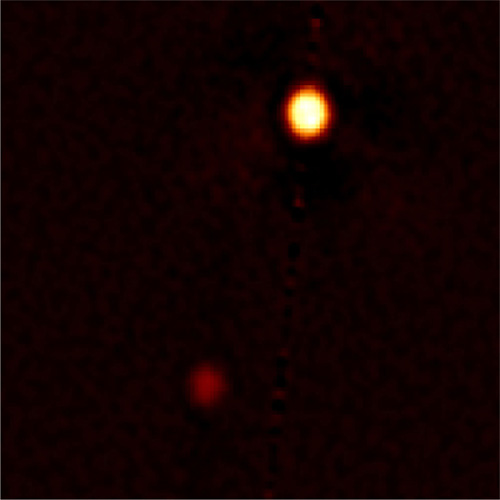Best Photo of Pluto from Earth Snapped by Hawaii Telescope

A ground-based telescope has snapped the sharpest image yet of Pluto and its moon Charon taken in visible light from Earth.
The Gemini North 8-meter telescope on Mauna Kea, Hawai'i captured the photo of the dwarf planet and its companion using a technique called reconstructive speckle imaging. The resulting image clearly shows the two bodies, which are nearly 3.7 billion miles (6 billion kilometers) from the sun — about 40 times the distance between the sun and Earth.
The success of the photo, which Gemini officials unveiled today (Sept. 26), suggests the method could be useful for imaging planets beyond our solar system as well, scientists say.
NASA's planet hunting spacecraft Kepler surveys a vast swath of stars looking for dips in their brightness caused by planets passing in front of them. To confirm these planets, scientists rely on ground-based observatories. Reconstructive speckle imaging, which combines multiple snapshots of the same object to achieve sharper images, could be used to enhance Earth-bound telescopes' ability to spot Earth-like planets around other stars initially discovered by Kepler.
"This is an enormous gain in the effort underway to confirm small Earth-size planets," study leader Steve Howell of the NASA Ames Research Center in California said in a statement.
Additionally, Pluto is of special interest to researchers now because NASA has already launched the first probe intended to study the body from up close. The New Horizons spacecraft lifted off in 2006 and is expected to arrive near Pluto in 2015. [Pluto's 5 Moons Explained (Infographic)]
"The Pluto-Charon result is of timely interest to those of us wanting to understand the orbital dynamics of this pair for the 2015 encounter by NASA's New Horizons spacecraft," Howell said.
Get the Space.com Newsletter
Breaking space news, the latest updates on rocket launches, skywatching events and more!
The resulting resolution is good enough to see a pair of car headlights in Providence, Rhode Island, all the way from San Francisco.
The photo was taken using a special camera temporarily attached to the Gemini scope called the Differential Speckle Survey Instrument (DSSI).
"This was a fantastic opportunity to bring DSSI to Gemini North this past July," said research team member Elliott Horch of Southern Connecticut State University. "In just a little over half an hour of Pluto observations, collecting light with the large Gemini mirror, we obtained the best resolution ever with the DSSI instrument –– it was stunning!"
Follow Clara Moskowitz on Twitter @ClaraMoskowitz or SPACE.com @Spacedotcom. We're also on Facebook & Google+.
Join our Space Forums to keep talking space on the latest missions, night sky and more! And if you have a news tip, correction or comment, let us know at: community@space.com.

Space.com is the premier source of space exploration, innovation and astronomy news, chronicling (and celebrating) humanity's ongoing expansion across the final frontier. Originally founded in 1999, Space.com is, and always has been, the passion of writers and editors who are space fans and also trained journalists. Our current news team consists of Editor-in-Chief Tariq Malik; Editor Hanneke Weitering, Senior Space Writer Mike Wall; Senior Writer Meghan Bartels; Senior Writer Chelsea Gohd, Senior Writer Tereza Pultarova and Staff Writer Alexander Cox, focusing on e-commerce. Senior Producer Steve Spaleta oversees our space videos, with Diana Whitcroft as our Social Media Editor.









